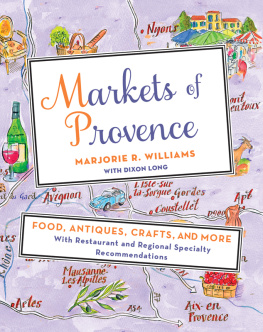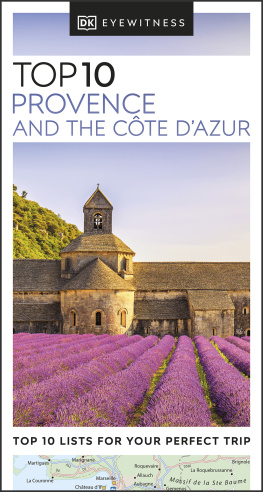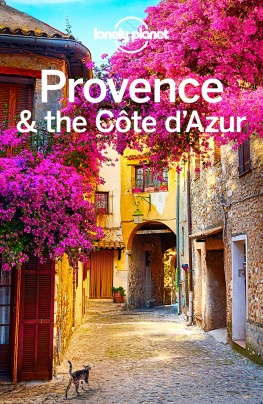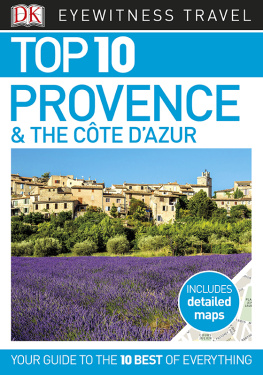Contents
Guide



MARKETS OF Provence
Food, Antiques, Crafts, and More
Text and photographs by
Marjorie R. Williams
with Dixon Long

The author and publisher have provided this e-book to you for your personal use only. You may not make this e-book publicly available in any way. Copyright infringement is against the law. If you believe the copy of this e-book you are reading infringes on the authors copyright, please notify the publisher at: http://us.macmillanusa.com/piracy.
To Michael
Le Paradis nest pas artificiel.
Ezra Pound

Provence is a place of extraordinary beauty and bounty. Breathtaking landscapes, blue sky, dazzling light, and a Mediterranean climate form a magical backdrop. The region has been described in countless paintings, films, and books. And yet, much mystery remains. Whats the best way to see, taste, and smell Provence?
The answer, I believe, is to visit its markets. They have been the heart of Provenal life since the Middle Ages. I began my research in 2012, returning in different seasons over a few years to see how the offerings change from summer to fall and winter to spring. I noticed similar itemsand often the same vendorsappearing in multiple markets. And yet, every market is unique. Each one takes on the shape and personality of the village. Further differences emerge in local specialties, traditions, and landscapes. You dont have to be fluent in French to enjoy them. Nor must you have a kitchen or be a hard-core shopper. Instead, think of markets as a way to experience Provenceits crops, customs, crafts, and culture.
Nearly every village and town has its own market, usually open one day a week. There are nearly 200, which Ive narrowed to 30 that stand out for their quality, range of goods, or something special about the setting. My focus is mainly between Aix-en-Provence to the south, Mont Ventoux to the north, the Alpes-de-Haute-Provence to the east, and the Rhne River to the west. Thats where theres the greatest concentration of exceptional markets.
The book is organized by day of the week so that you can easily identify which options are available on any given day. Each chapter opens with a map showing the recommended markets that day. Orange diamonds identify those that I consider the best. Purple dots indicate others that might be worth a stop if you are nearby. Some towns have more than one type of market on different days. A few, such as Les Halles dAvignon and the market in Aix-en-Provence, are open several days weekly. In those cases, the market is described fully only once with page references to it elsewhere.
My aim is to inspire and inform you. Whether you explore one market or several, and whether on your own or as part of a group, this book will make the planning more reliable and the rewards richer. It will spare you the disappointment of being in the right place at the wrong time. Saint-Rmy is terrific anytime, but if youre there on market day (Wednesday) youll double the fun.
The ancient Romans built bridges and roads to connect the villages. But everyone who goes to Provence cuts a unique path through this enchanted land. While its impossible to grasp its depths in a single visitor in a lifetimeseeing Provence through its markets reveals something essential about its soil and its soul. Come along and enjoy the journey. It will be one youll never forget.
TRADITIONAL PROVENAL MARKETS
(Marchs Provenaux, Marchs Hebdomadaires)
These are the most common type of market in Provence. Theyre held outdoors year-round (though smaller in winter), from about 8:30 a.m. to noon, usually only once a week. Vendors sell fresh ingredients, prepared foods, flowers, and souvenirs. Farmers might bring local produce; however, these are not farmers markets in the pure sense (for that, see below). Some (grands marchs) are large and diverse. Others are trs petit but still cover the basics. Village markets have a markedly different ambience from city markets.
FLEA AND ANTIQUES MARKETS
(Marchs des Antiquits, Brocantes, Puces, and Vide Greniers)
Professional dealers sell at les marchs des antiquits. Brocantes are simpler marketplaces of dealers who rove from town to town selling secondhand items. At vide greniers (attic-emptiers, akin to yard sales or car-trunk sales), individuals cast off unwanted household itemsoften junk, but the occasional dusty treasure.
COVERED MARKETS
(Les Halles)
Indoor markets are open most weekdays, both morning and afternoon. The covered structures help maintain a constant temperature. The main covered markets are in Avignon and Nmes.
FARMERS MARKETS
(Marchs Paysans, Marchs des Producteurs, Marchs Agricoles)
Farmers bring seasonal produce (and cheese, jams, honey, and wine) to sell directly. These markets are well supported by the locals, who appreciate the direct connection with producers. Certified organic is indicated by AB signage (Agriculture Biologique).
EVENING MARKETS
(Marchs du Soir)
Evening markets usually feature the local farmers and sometimes include an animation such as a cooking demonstration.
CRAFT MARKETS
(Marchs des Artisans, Marchs des Crateurs)
Local artisans sell jewelry, accessories, and other crafts. Some towns attempt to maintain a quality standard. Others have looser rules, and the tacky quotient can soar.
SPECIALTY MARKETS
Truffle markets, Christmas markets, and santon markets feature seasonal highlights and attract eager shoppers during the winter.
FARM VISIT MARKETS
(Marchs la Ferme)
Many farmers participate in the Bienvenue la Ferme program during the growing season, welcoming visitors to their farms.

Timing. Traditional markets are busiest from 9 to 11 a.m. Most begin to close at noon. Arrive by 8:30 for the best selection and decent parking, leaving sightseeing for the afternoon. Consider whether youll need to cross the Luberon mountain. Driving through narrow passes makes for stunning views but takes longer.
Parking.





















